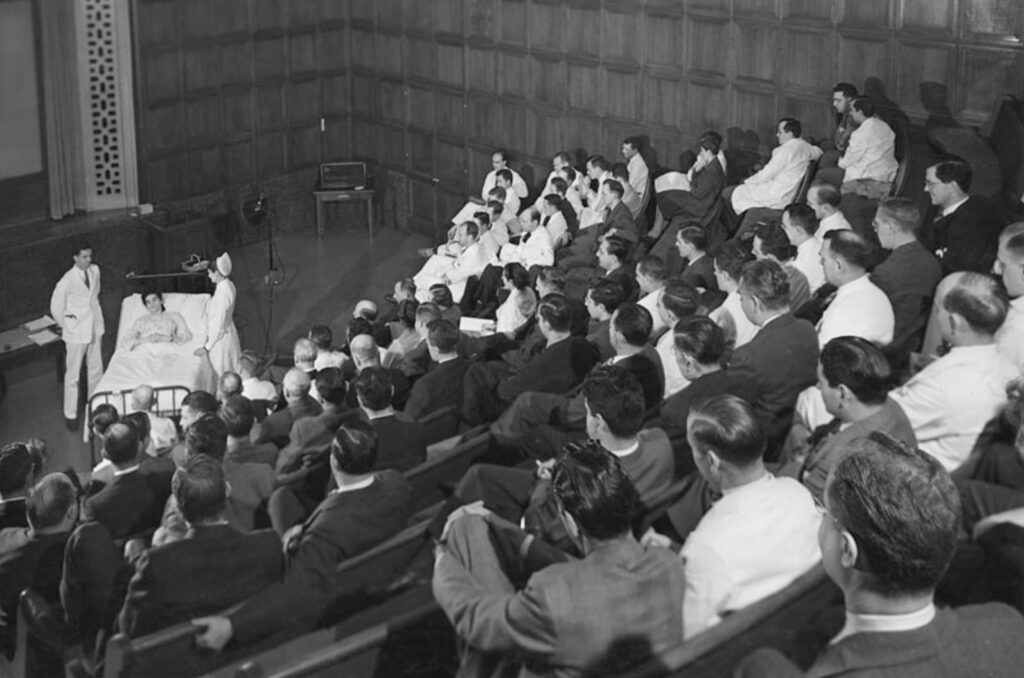The Power of Storytelling: Selling the Future of Medicine
Doctor’s orders: you are what you eat, and you’re also as influential as the stories you tell. How to use the power of storytelling to build shared belief around healthcare innovation and the future of medicine.
🩺 Whispers from white coats.
💡 Dim lights. Footsteps echo up towards the ceiling.
📽 Click. The projector light snaps everyone to attention.
🖐🏽 “May I have the first slide please?”
Grand Rounds are now underway, and another seemingly unsolvable patient case is presented.

Grand Rounds are the ultimate storytime “show and tell.” The story of a complex medical problem is devoured by everyone in attendance. A patient story is shared, expert wisdom is distilled down and collective belief in medical marvel is alive and well.
Today, Grand Rounds and bedside rounds are still routinely practiced in hospitals across the world. Yet, beyond the hospital walls, in a present-day society where distrust is the default, medical leaders are struggling to build buy-in and shared belief around new medical technology and innovations in healthcare.
Biotech leaders, medical innovators and pharmaceutical companies are now asking themselves, how do you engage:
- Burned out healthcare teams?
- Policy leaders caught in a cycle of distrust?
- A divisive and wary public?
Enter the power of storytelling: raw, authentic, empathetic human to human stories – similar to the stories that Grand Rounds captured and translated so well.
In this article, take away:
- Why storytelling is powerful in building shared belief
- How to use storytelling to sell your problem, not your product
- Powerful storytelling tips you can start using today
The Power of Storytelling to Build Shared Belief
Storytelling and science. Both, in their most primal form, have been around since the beginning of human record, and both have the power to fundamentally change the course of history.
Today, we have the technology to unpack why storytelling is so powerful when it comes to connecting us to others, inspiring shared belief and spurring action.
Functional MRI scans show how storytelling – a joint activity – promotes speaker-listener neural coupling, a fancy way of saying that when you listen to a story, your brain waves sync with those of the storyteller.
“The power of storytelling is exactly this: to bridge the gaps where everything else has crumbled.”
- Paulo Coelho Tweet
Storytelling is a critical way to shape and strengthen beliefs, and cultivating shared belief is critical when asking an audience to work towards a new shared future: a future vision, future product, future technology or future partnership.
But, here’s the thing:
As we’ve witnessed during COVID-19, often the medical technology and care delivery answers are there, but what proves more challenging than innovating, is getting buy-in from the audience to adopt your product, plan or pathway.
New medical technologies, pressures on the healthcare system, data-driven insights, the shift from hospital to home and patient-centric policies are just a few of the forces requiring healthcare leaders to embrace innovations in care delivery.
And, after years of unprecedented social, economic and political turbulence, building trust and influence is now an uphill battle.
The good news is the answer lies in returning to our roots, resurrecting the historical legacy of storytelling in medicine, and the power of storytelling to connect us to others – it’s in our DNA.
So, just how do you use storytelling to gain collective buy-in and sell the future of medicine?
Disrupt Inertia: Use Storytelling to Sell the Problem NOT the Prospect
Just as we are biologically hard-wired to respond to stories, we are also hard-wired to be resistant to change.
🤔 Hmm…you might be thinking, well aren’t some of us less change-resistant than others?
🍎 Yes, but here’s the truth:
When it comes to companies, leaders and systems, most follow Sir Isaac Newton’s first law of motion: objects tend to keep moving in the same direction unless a strong force causes them to change.
So what strong force can we use to disrupt inertia?
☄️ Storytelling is that strong force!

And here’s a second thing:
Don’t use storytelling to sell your, idea or partnership, use it to sell your problem.
Why?
People are more emotional and connected to the problems they face, than they ever will be about your product or idea (sorry).
Rather than convincing someone to adopt your idea, it’s easier to:
✅ Listen and demonstrate listening to build trust
✅ Build rapport over a shared understanding of a problem
✅ Connect through empathy first, before using facts and figures
✅ Highlight pain points to inspire action
Whether you are:
- adopting a new change management strategy,
- shifting internal structures and priorities,
- launching a new strategic plan,
- pitching critical policy changes, or
- bringing a new product to market,
Start your story with the problem FIRST and then invite your audience into a new shared world of possibility that removes barriers and solves pain points to create an abundant future.
Powerful Storytelling Tips to Start Using Today (Recap)
Building influence and trust are the currency of leadership in 2022. Today, leaders must have the courage to empathize with people’s fears and challenges and communicate with clarity and conviction.
So, how do you do that?
Start with a story.
The most influential and trustworthy stories:
- Are born out of empathy
- Demonstrate vulnerability
- Create shared purpose
- Use credible information from expert sources
- Demonstrate meaningful, accountable action
The next time you are: leading a team meeting, holding an important sales call, rolling out a new strategy – start with a story. Use the points above as a mini-checklist to structure a story that will disrupt interia. Remember, to sell the problem, not the product, and balance facts and figures with empathy and shared compassion.
Looking for more information on how to harness the power of storytelling?
Read: https://hbr.org/2020/10/storytelling-can-make-or-break-your-leadership
Watch: TED | The magical science of storytelling: The magical science of storytelling | David JP Phillips | TEDxStockholm
Do: Connect through empathy first, before facts and figures.
Contact: Get in touch below and ask to take our exclusive influence styles assessment.





